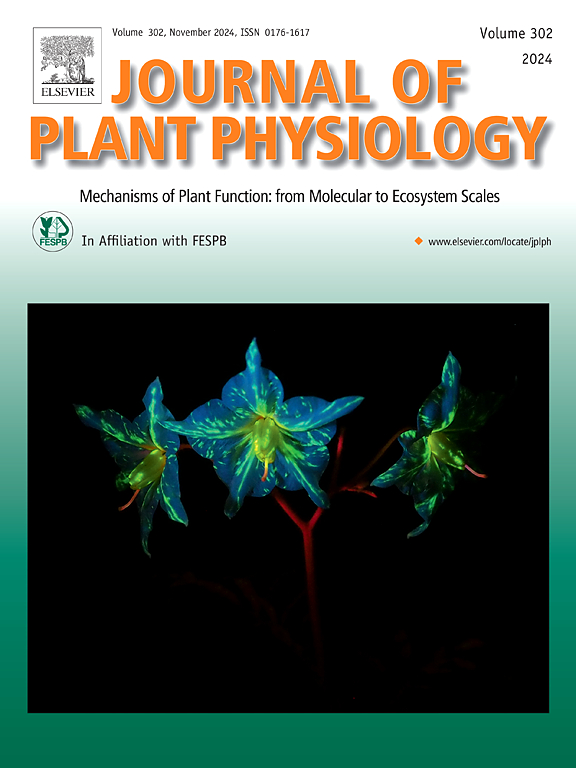ABA参与osdsr3介导的水稻耐碱调控
IF 4.1
3区 生物学
Q1 PLANT SCIENCES
引用次数: 0
摘要
碱胁迫是影响水稻生长和产量的最具破坏性的非生物胁迫之一。未知功能域(DUF)蛋白家族和脱落酸(ABA)在植物的非生物抗性中起着至关重要的作用。我们之前从DUF966家族中发现了一个新的胁迫响应基因OsDSR3,该基因积极调节水稻对碱胁迫的耐受性。然而,目前尚不清楚OsDSR3是否依赖ABA信号来调节水稻抗碱的分子机制。通过RNA测序和RT-qPCR,我们发现碱性胁迫下OsDSR3过表达系aba相关基因的差异表达。进一步分析表明,OsDSR3过表达系对ABA处理的敏感性增加,而OsDSR3突变株则表现出相反的表型。与这些发现一致的是,与野生型相比,OsDSR3过表达系的ABA含量显著高于OsDSR3突变体,而OsDSR3突变体的ABA含量显著低于野生型。此外,外源ABA的施用增强了OsDSR3过表达系的耐碱能力。这种增强归因于抗氧化酶(超氧化物歧化酶、过氧化物酶和过氧化氢酶)活性的增加、渗透调节物质(脯氨酸、可溶性蛋白)水平的升高、活性氧(ROS包括超氧阴离子和过氧化氢)水平的降低、膜完整性的维持、内源ABA水平的积累以及与ABA信号相关的基因表达的激活。这些影响在OsDSR3过表达系中比在OsDSR3突变株中更为明显。此外,通过酵母双杂交实验,我们证明了OsDSR3与OsMT-3a相互作用。这种相互作用增强了通过ABA途径清除活性氧,从而正向调节水稻的碱耐受性。本研究为OsDSR3调控碱胁迫的机制提供了更深入的认识。本文章由计算机程序翻译,如有差异,请以英文原文为准。
ABA is involved in OsDSR3-mediated regulation of alkali tolerance in rice
Alkali stress is one of the most damaging abiotic stresses that affect rice growth and yield. The Domain of unknown function (DUF) protein family and abscisic acid (ABA) are critical for abiotic stress tolerance in plants. We previously identified OsDSR3, a novel stress-responsive gene from the DUF966 family that positively regulates rice tolerance to alkali stress. However, it remains unclear whether OsDSR3 relies on the ABA signaling to modulate the molecular mechanisms underlying rice alkali resistance. Using RNA sequencing and RT-qPCR, we found differential expression of ABA-related genes in OsDSR3 overexpression lines under alkaline stress. Further analysis revealed that OsDSR3 overexpression lines exhibited increased sensitivity to ABA treatment, whereas osdsr3 mutants exhibited the opposite phenotype. Consistent with these findings, the ABA content was significantly higher in OsDSR3 overexpression lines and lower in osdsr3 mutants compared to wild type. In addition, the exogenous ABA application enhanced the alkali tolerance of OsDSR3 overexpression lines. This enhancement was attributed to the increased activity of antioxidant enzymes (superoxide dismutase, peroxidase, and catalase), elevated levels of osmotic regulating substances (proline, soluble proteins), reduced levels of reactive oxygen species (ROS including superoxide anion and hydrogen peroxide), maintenance of membrane integrity, accumulation of endogenous ABA levels, and activation of gene expression related to the ABA signaling. These effects were significantly more pronounced in OsDSR3 overexpression lines than in the osdsr3 mutant. Furthermore, using a yeast two-hybrid assay, we demonstrated that OsDSR3 interacts with OsMT-3a. This interaction enhances ROS scavenging via the ABA pathway, thereby positively regulating alkaline tolerance in rice. This study provides deeper insight into the mechanism of OsDSR3 regulating alkali stress.
求助全文
通过发布文献求助,成功后即可免费获取论文全文。
去求助
来源期刊

Journal of plant physiology
生物-植物科学
CiteScore
7.20
自引率
4.70%
发文量
196
审稿时长
32 days
期刊介绍:
The Journal of Plant Physiology is a broad-spectrum journal that welcomes high-quality submissions in all major areas of plant physiology, including plant biochemistry, functional biotechnology, computational and synthetic plant biology, growth and development, photosynthesis and respiration, transport and translocation, plant-microbe interactions, biotic and abiotic stress. Studies are welcome at all levels of integration ranging from molecules and cells to organisms and their environments and are expected to use state-of-the-art methodologies. Pure gene expression studies are not within the focus of our journal. To be considered for publication, papers must significantly contribute to the mechanistic understanding of physiological processes, and not be merely descriptive, or confirmatory of previous results. We encourage the submission of papers that explore the physiology of non-model as well as accepted model species and those that bridge basic and applied research. For instance, studies on agricultural plants that show new physiological mechanisms to improve agricultural efficiency are welcome. Studies performed under uncontrolled situations (e.g. field conditions) not providing mechanistic insight will not be considered for publication.
The Journal of Plant Physiology publishes several types of articles: Original Research Articles, Reviews, Perspectives Articles, and Short Communications. Reviews and Perspectives will be solicited by the Editors; unsolicited reviews are also welcome but only from authors with a strong track record in the field of the review. Original research papers comprise the majority of published contributions.
 求助内容:
求助内容: 应助结果提醒方式:
应助结果提醒方式:


